Satellite Signatures of Pre-Seismic Atmospheric Anomalies of 6 February 2023 Türkiye Earthquakes
Abstract
1. Introduction
2. Materials and Methods
2.1. Earthquake Precursors
2.2. Study Area and Geotectonic Setting
2.3. Datasets
2.4. Methodology
3. Results and Discussion
3.1. Climate Parameters Evolution
3.2. Temporal Pattern of Outgoing Long Wave Radiation (OLR)
3.3. Land Surface Temperature (LST)
4. Conclusions
Author Contributions
Funding
Institutional Review Board Statement
Informed Consent Statement
Data Availability Statement
Acknowledgments
Conflicts of Interest
References
- Yetkin, M.; Dedeoğlu, I.O.; Tunç, G. 6 February 2023, Kahramanmaraş twin earthquakes: Evaluation of ground motions and seismic performance of buildings for Elazığ, southEast of Türkiye. Soil Dyn. Earthq. Eng. 2024, 181, 108678. [Google Scholar] [CrossRef]
- U.S. Geological Survey. M 7.8–26 km ENE of Nurdağı, Türkiye. 2023. Available online: https://earthquake.usgs.gov/earthquakes/eventpage/us6000jllz/executive (accessed on 15 February 2023).
- U.S. Geological Survey. M 7.5–4 km SSE of Ekinözül, Türkiye. 2023. Available online: https://earthquake.usgs.gov/earthquakes/eventpage/us6000jlqa/executive (accessed on 15 February 2023).
- KOERI.Kandilli Observatory; Earthquake Research Institute. Boğaziçi University, Istanbul, Türkiye. Available online: http://www.koeri.boun.edu.tr (accessed on 10 March 2023).
- Meng, J.; Kusky, T.; Mooney, W.D.; Bozkurt, E.; Bodur, M.N.; Wang, L. Surface Deformations of the 6 February 2023 earthquake Sequence, Eastern Türkiye. Science 2024, 383, 298–305. [Google Scholar] [CrossRef] [PubMed]
- Provost, F.; Karabacak, V.; Malet, J.P.; Van der Woerd, J.; Meghraoui, M.; Masson, F.; Ferry, M.; Michéa, D.; Pointal, E. High-resolution co-seismic fault offsets of the 2023 Türkiye earthquake ruptures using satellite imagery. Sci Rep. 2024, 14, 6834. [Google Scholar] [CrossRef] [PubMed]
- DEMA. Earthquake Department of the Disaster and Emergency Management Presidency. Ankara, Türkiye. Available online: http://www.afad.gov.tr (accessed on 10 March 2023).
- Jordan, T.H.; Chen, Y.-T.; Gasparini, P.; Madariaga, R.; Main, I.; Marzocchi, W.; Papadopoulos, G.; Sobolev, G.; Yamaoka, K.; Zschau, J. OPERATIONAL earthquake FORECASTING. State of Knowledge and Guidelines for Utilization. Ann. Geophys. 2011, 54, 316–391. [Google Scholar] [CrossRef]
- Bormann, P. From earthquake Prediction Research to Time-Variable Seismic Hazard Assessment Applications. Pure Appl. Geophys. 2011, 168, 329–366. [Google Scholar] [CrossRef]
- Sornette, D.; Ouillon, G.; Mignan, A.; Freund, F. Preface to the Global earthquake Forecasting System (GEFS) special issue: Towards using non-seismic precursors for the prediction of large earthquakes. Eur. Phys. J. Spec. Top. 2021, 230, 1–5. [Google Scholar] [CrossRef]
- Tobita, T.; Kiyota, T.; Torisu, S.; Cinicioglu, O.; Tonuk, G.; Milev, N.; Contreras, J.; Contreras, O.; Shiga, M. Geotechnical damage survey report on 6 February 2023 Türkiye-Syria earthquake, Türkiye. Soils Found. 2024, 64, 101463. [Google Scholar] [CrossRef]
- Pulinets, S.; Budnikov, P.; Karelin, A.; Žalohar, J. Thermodynamic instability of the atmospheric boundary layer stimulated by tectonic and seismic activity. J. Atmos. Sol. Terr. Phys. 2023, 246, 106050. [Google Scholar] [CrossRef]
- Lu, K.; Hou, M.; Jiang, Z.; Wang, Q.; Sun, G.; Liu, J. Understanding earthquake from the Granular Physics Point of View-Causesof earthquake, earthquake Precursors and Predictions. Int. J. Mod. Phys. B 2018, 32, 1850081. [Google Scholar] [CrossRef]
- Xiong, P.; Shen, X.H.; Bi, Y.X.; Kang, C.L.; Chen, L.Z.; Jing, F.; Chen, Y. Study of Outgoing Longwave Radiation Anomalies Associated with Haiti Earth quake. Nat. Hazards Earth Syst. Sci. 2010, 10, 2169–2178. [Google Scholar] [CrossRef]
- Sun, R.; Wang, J.; Cheng, Q.; Mao, Y.; Ochieng, W.Y. A New IMU-Aided Multiple GNSS Fault Detection and Exclusion Algorithm for Integrated Navigation in Urban Environments. GPS Solut. 2021, 25, 147. [Google Scholar] [CrossRef]
- Jiao, Z.; Shan, X. Pre-Seismic Temporal Integrated Anomalies from Multiparametric Remote Sensing Data. Remote Sens. 2022, 14, 2343. [Google Scholar] [CrossRef]
- Pulinets, S.; Ouzounov, D. Lithosphere–Atmosphere–Ionosphere Coupling (LAIC) Model—An Unified Concept for Earth quake Precursors Validation. J. Asian Earth Sci. 2011, 41, 371–382. [Google Scholar] [CrossRef]
- Dong, W.; Yang, Y.; Qu, J.; Xiao, S.; Li, Y. Local Information-Enhanced Graph-Transformer for Hyperspectral Image Change Detection with Limited Training Samples. IEEE Trans. Geosci. Remote Sens. 2023, 61, 5509814. [Google Scholar] [CrossRef]
- Wu, L.; Qin, K.; Liu, S. GEOSS-Based Thermal Parameters Analysis for earthquake Anomaly Recognition. Proc. IEEE 2012, 100, 2891–2907. [Google Scholar] [CrossRef]
- Vesnin, A.; Yasyukevich, Y.; Perevalova, N.; Senturk, E. Ionospheric Response to the 6 February 2023 Türkiye–Syria Earth quake. Remote Sens. 2023, 15, 2336. [Google Scholar] [CrossRef]
- Bari Jahed, A.; Aydan, Ö.; Ito, T.; Iwata, N. Evaluation of crustal deformation and associated strong motions induced by the 2022 Paktika earthquake, Afghanistan. Earthq. Sci. 2024, 37, 546–557. [Google Scholar] [CrossRef]
- Ranjan, P.; Konstantinou, K.I. Local earthquake tomography of the Aegean crust: Implications for active deformation, large earthquakes, and arc volcanism. Tectonophysics 2024, 880, 230331. [Google Scholar] [CrossRef]
- Şahin, U.A.; Kaynak, B. Questioning whether there was a short-term interaction between the 6 February 2023 earthquakes and air quality parameters in Türkiye. Chemosphere 2024, 347, 140616. [Google Scholar] [CrossRef]
- Kutoglu, H.; Ghasempour, F.; Sekertekin, F. Investigation of Possible MODIS AOD Anomalies as earthquake Precursors for Global earthquakes. Adv. Space Res. 2021, 68, 3531–3545. [Google Scholar] [CrossRef]
- Varotsos, C.A.; Efstathiou, M.N.; Cracknell, A.P. On the association of aerosol optical depth and total ozone fluctuations with recent earthquakes in Greece. Acta Geophys. 2017, 65, 659–665. [Google Scholar] [CrossRef]
- Zoran, M.; Savastru, R.; Savastru, D. Ground based 222 Radon observations in Bucharest, Romania and their application to geophysics. J. Radioanal. Nucl. Chem. 2012, 293, 877–888. [Google Scholar] [CrossRef]
- Muafiry, I.N.; Meilano, I.; Wijaya, D.D.; Sentürk, E.; Heki, K. Ionospheric changes immediately before the 2023 February Kahramanmaras earthquakes, Türkiye. Adv. Space Res. 2024. [Google Scholar] [CrossRef]
- Heki, K. Ionospheric electron enhancement preceding the 2011 Tohoku-oki earthquake. Geophys. Res. Lett. 2011, 38, L17312. [Google Scholar] [CrossRef]
- Heki, K.; Nakatani, M.; Zhan, W. Ionospheric changes immediately before the 2008 Wenchuan earthquake. Adv. Space Res. 2024, 73, 4539–4545. [Google Scholar] [CrossRef]
- Su, J.; Chen, H. Study on the mechanism of atmospheric electric field anomalies before earthquakes. Results Geophys. Sci. 2023, 15, 100060. [Google Scholar] [CrossRef]
- Wang, T.; Zhu, S.N.; Yang, C.S.; Wei, Y.J.; Zhao, C.Y.; Hou, H.C. Co- and Post-seismic Deformation Mechanisms of the 2020 Mw6.0 Jiashi earthquake in Xinjiang (China), Revealed by Sentinel-1 InSAR Observations. Front. Environ. Sci. 2022, 10, 933200. [Google Scholar] [CrossRef]
- Colonna, R.; Filizzola, C.; Genzano, N.; Lisi, M.; Tramutoli, V. Optimal Setting of earthquake-Related Ionospheric TEC (Total Electron Content) Anomalies Detection Methods: Long-Term Validation over the Italian Region. Geosciences 2023, 13, 150. [Google Scholar] [CrossRef]
- Fraser, J.; Vanneste, K.; Ferrari, H. Recent behavior of the North Anatolian Fault: Insights from an integrated paleoseismological data set. J. Geophys. Res. 2010, 115, B09316. [Google Scholar] [CrossRef]
- Sengor, A.; Tuysuz, O.; Imren, C.; Sakinc, M.; Eyidogan, H.; Gorur, N.; Le Pichon, X.; Rangin, C. The North Anatolian Fault: A new look. Annu. Rev. Earth Panet. Sci. 2005, 33, 37–112. [Google Scholar] [CrossRef]
- Gomez, F.; Cochran, W.J.; Yassminh, R.; Jaafar, R.; Reilinger, R.; Floyd, M.; King, R.W.; Barazangi, M. Fragmentation of the Sinai Plate indicated by spatial variation in present-day slip rate along the Dead Sea Fault System. Geophys. J. Int. 2020, 221, 1913–1940. [Google Scholar] [CrossRef]
- Goldberg, D.E.; Taymaz, T.; Reitman, N.G.; Hatem, A.E.; Yolsal-Çevikbilen, S.; Barnhart, W.D.; Serkan Irmak, T.; Wald, D.J.; Öcalan, T.; Altuntaş, C.; et al. Rapid characterization of the February 2023 Kahramanmaraş, Türkiye, earthquake sequence. Seism. Rec. 2023, 3, 156–167. [Google Scholar] [CrossRef]
- Delph, J.R.; Darin, M.H.; Whitney, D.L.; Cosca, M.A.; Teyssier, C.; Kaymakci, N.; Eken, T.; Reid, M.R.; Beck, S.L. Deep Lithospheric Controls on Surface Deformation and Seismicity around the East Anatolian Fault Zone and A3 Triple Junction. GSA Today 2024, 34, 4–12. [Google Scholar] [CrossRef]
- Özbey, V.; Sengör, A.M.C.; Henry, P.; Özeren, M.S.; Haines, A.J.; Klein, E.C.; Tarı, E.; Zabcı, C.; Chousianitis, K.; Güvercin, S.E.; et al. Kinematics of the Kahramanmaraş triple junction and of Cyprus: Evidence of shear partitioning. BSGF Earth Sci. Bullet. 2024, 195, 15. [Google Scholar] [CrossRef]
- Tan, O. Long-term aftershock properties of the catastrophic 6 February 2023 kahramanmaraş (Türkiye) earthquake sequence. Acta Geophy. 2024, 1–18. [Google Scholar] [CrossRef]
- Maletckii, B.; Astafyeva, E.; Sanchez, S.A.; De Paula, E.R. The 6 February 2023 Turkiye earthquake Sequence as Detected in the Ionosphere. J. Geophys. Res. Space Phys. 2023, 128, e2023JA031663. [Google Scholar] [CrossRef]
- GIOVANNI. Geospatial Interactive Online Visualization and Analysis Infrastructure GIOVANNI. 2024. Available online: https://giovanni.gsfc.nasa.gov/giovanni (accessed on 20 September 2024).
- MERRA. 2024. Available online: http://www.soda-pro.com/web-services/meteo-data/merra (accessed on 25 September 2024).
- NOAA. Physical Sciences Laboratory. 2024. Available online: Phttps://psl.noaa.gov/data/composites/day/ (accessed on 20 September 2024).
- MODIS. 2024. Available online: https://modis.ornl.gov/data.html (accessed on 12 September 2024).
- Wan, Z.; Hook, S.; Hulley, G. MOD11A2 MODIS/Aqua Land Surface Temperature/Emissivity 8-Day L3 Global 1 km SIN Grid V061: NASA EOSDIS Land Processes DAAC; NASA EOSDIS Land Processes Distributed Active Archive Center: Sioux Falls, SC, USA, 2021. [Google Scholar] [CrossRef]
- Copernicus. 2024. Available online: https://cds.climate.copernicus.eu/ (accessed on 20 September 2024).
- Dobrovolsky, I.P.; Zubkov, S.I.; Miachkin, V.I. Estimation of the size of earthquake preparation zones. Pure Appl. Geophys. 1979, 117, 1025–1044. [Google Scholar] [CrossRef]
- Bowman, D.D.; Ouillon, G.; Sammis, C.G.; Sornette, A.; Sornette, D. An Observational Test of the Critical earthquake Concept. J. Geophys. Res. 1998, 103, 359372–359424. [Google Scholar] [CrossRef]
- Zoran, M. MODIS and NOAA-AVHRR land surface temperature data detect a thermal anomaly preceding the 11 March 2011 Tohoku earthquake. Int. J. Remote Sens. 2012, 33, 6805–6817. [Google Scholar] [CrossRef]
- Ghosh, S.; Sasmal, S.; Maity, S.K.; Potirakis, S.M.; Hayakawa, M. Thermal Anomalies Observed during the CreteEarthquake on 27 September 2021. Geosciences 2024, 14, 73. [Google Scholar] [CrossRef]
- Haider, S.F.; Shah, M.; Alarifi, N.S.; Abukhadra, M.R. The 2023 Mw 6.8 Morocco earthquake induced atmospheric and ionospheric anomalies. J. Atmos. Sol. Terr. Phys. 2024, 262, 106323. [Google Scholar] [CrossRef]
- Qasim, M.; Shah, M.; Shahzad, R.; Jamjareegulgarn, P. Atmospheric precursors from multiple satellites associated with the 2020 Mw 6.5 Idaho (USA) earthquake. Adv. Space Res. 2024, 73, 106323. [Google Scholar] [CrossRef]
- Khan, M.M.; Ghaffar, B.; Shahzad, R.; Khan, M.R.; Shah, M.; Amin, A.H.; Ali, R. Atmospheric anomalies associated with the 2021 M w 7.2 Haiti earthquake using machine learning from multiple satellites. Sustainability 2022, 14, 14782. [Google Scholar] [CrossRef]
- Filizzola, C.; Corrado, A.; Genzano, N.; Lisi, M.; Pergola, N.; Colonna, R.; Tramutoli, V. RST Analysis of Anomalous TIR Sequences in Relation with earthquakes Occurred in Türkiye in the Period 2004–2015. Remote Sens. 2022, 14, 381. [Google Scholar] [CrossRef]
- Haider, S.F.; Shah, M.; Li, B.; Jamjareegulgarn, P.; de Oliveira-Junior, J.F.; Zhou, C. Synchronized and Co-Located Ionospheric and Atmospheric Anomalies Associated with the 2023 Mw 7.8 Türkiye earthquake. Remote Sens. 2024, 16, 222. [Google Scholar] [CrossRef]
- Akhoondzadeh, M.; Marchetti, D. Study of the Preparation Phase of Türkiye’s Powerful earthquake (6 February 2023) by a Geophysical MultiParametric Fuzzy Inference System. Remote Sens. 2023, 15, 2224. [Google Scholar] [CrossRef]
- Pulinets, S.; Budnikov, P. Atmosphere critical processes sensing with ACP. Atmosphere 2022, 13, 1920. [Google Scholar] [CrossRef]
- Szakács, A. Precursor-Based earthquake Prediction Research: Proposal for a Paradigm-Shifting Strategy. Front. Earth Sci. 2021, 8, 548398. [Google Scholar] [CrossRef]
- De Santis, A.; Cianchini, G.; Marchetti, D.; Piscini, A. A Multiparametric Approach to Study the Preparation Phase of the 2019 M7.1 Ridgecrest (California, United States) earthquake. Front. Earth Sci. 2020, 8, 540398. [Google Scholar] [CrossRef]
- Martinelli, G.; Peresan, A.; Li, Y. Editorial: Achievements and New Frontiers in Research Oriented to earthquake Forecasting. Front. Earth Sci. 2021, 9, 793911. [Google Scholar] [CrossRef]
- Guo, A.; Jiang, N.; Xu, Y.; Xu, T.; Wu, Y.; Li, S.; Gao, Z. Co-seismic characterization analysis in PWV and land-atmospheric observations associated with Luding Ms 6.8 earthquake occurrence in China on 5 September 2022. Geomat. Nat. Hazards Risk 2023, 14, 2279494. [Google Scholar] [CrossRef]
- Satti, M.S.; Ehsan, M.; Abbas, A.; Shah, M.; de Oliveira-Júnior, J.F.; Naqvi, N.A. Atmospheric and Ionospheric Precursors Associated with Mw ≥ 6.5 earthquakes 8 from Multiple Satellites. J. Atmos. Sol. Terr. Phys. 2022, 227, 105802. [Google Scholar] [CrossRef]
- Shah, M.; Calabia, A.; Tariq, M.A.; Ahmed, J.; Ahmed, A. Possible ionosphere and atmosphere precursory analysis related to Mw >6.0 earthquakes in Japan. Remote Sens. Environ. 2020, 239, 111620. [Google Scholar] [CrossRef]
- Venkatanathan, N.; Kaarthick, B.; Priyadharshini, C. OLR Anomalies Prior to Big earthquakes (Mw > 6.0)—A Case Study on earthquakes of India’s Neighboring Region Occurred during the Year 2012. New Concepts Glob. Tecton. 2013, 1, 34–44. [Google Scholar]
- Shah, M.; Draz, M.U.; Saleem, T.A. Comprehensive Study on the synchronized Outgoing Longwave Radiation and Relative Humidity Anomalies related to global Mw ≥ 6.5 earthquakes. Nat. Hazards 2023, 7, 24–46. [Google Scholar] [CrossRef]
- Hameed, A.; Shah, M.; Ghaffar, B.; Riaz, S.; Jamjareegulgarn, P.; Alarifi, N.S.; Abukhadra, M.R. Possible atmospheric-ionospheric precursors of the 2020 Hotan China earthquake from various satellites. Adv. Space Res. 2024, 74, 3326–3343. [Google Scholar] [CrossRef]
- Mahmood, I.; Iqbal, M.F.; Shahzad, M.I.; Qaiser, S. Investigation of Atmospheric Anomalies Associated with Kashmir and Awaran earthquakes. J. Atmos. Sol. Terr. Phys. 2017, 154, 75–85. [Google Scholar] [CrossRef]
- Nikulin, S.; Sergieieva, K.; Korobko, O.; Kashtan, V. Using the Contrast Boundary Concentration of LST for the earthquake Approach Assessment in Türkiye, 6–8 February 2023. Earth 2024, 5, 388–403. [Google Scholar] [CrossRef]
- Simha, C.P.; Natarajan, V.; Dumka, R.; Rao, K.M. Spatial and temporal behaviour of Ionospheric VTEC and Atmospheric parameters before New Zealand earthquake on 13 November 2016 (M 7.8). J. Appl. Geophys. 2023, 212, 104989. [Google Scholar] [CrossRef]
- Dal Zilio, L.; Ampuero, J.P. earthquake doublet in Türkiye and Syria. Commun. Earth Environ. 2023, 4, 71. [Google Scholar] [CrossRef]
- Draz, M.U.; Shah, M.; Jamjareegulgarn, P.; Shahzad, R.; Hasan, A.M.; Ghamry, N.A. Deep machine learning based possible atmospheric and ionospheric precursors of the 2021 Mw 7.1 Japan earthquake. Remote Sens. 2023, 15, 1904. [Google Scholar] [CrossRef]
- Jing, F.; Zhang, L.; Singh, R.P.; Chauhan, A.; Jiang, M. Quasi-coseismic variations and geosphere coupling associated with the strong 2023 Türkiye earthquakes. Sci. Total Environ. 2024, 907, 167963. [Google Scholar] [CrossRef] [PubMed]
- Khan, S.; Shah, M.; Jamjareegulgarn, P.; Alarifi, N.S.; Abukhadra, M.R.; Khan, M. Remotely sensed atmospheric anomalies of the 2022 Mw 7.0 Bantay, Philippines Earthquake. Adv. Space Res. 2024, in press. [Google Scholar] [CrossRef]
- Freund, F.T. Pre-Earthquake signals: Underlying physical processes. J. Asian Earth Sci. 2011, 41, 383–400. [Google Scholar] [CrossRef]
- Pulinets, S.; Ouzounov, D.; Karelin, A.; Boyarchuk, K. Earthquake Precursors in the Atmosphere and Ionosphere: New Concepts; Springer: Berlin/Heidelberg, Germany, 2022. [Google Scholar] [CrossRef]
- Pulinets, S.A.; Dunajecka, M.A. Specific variations of air temperature and relative humidity around the time of Michoacan earthquake M8.1 19 September 1985 as a possible indicator of interaction between tectonic plates. Tectonophysics 2007, 431, 221–230. [Google Scholar] [CrossRef]


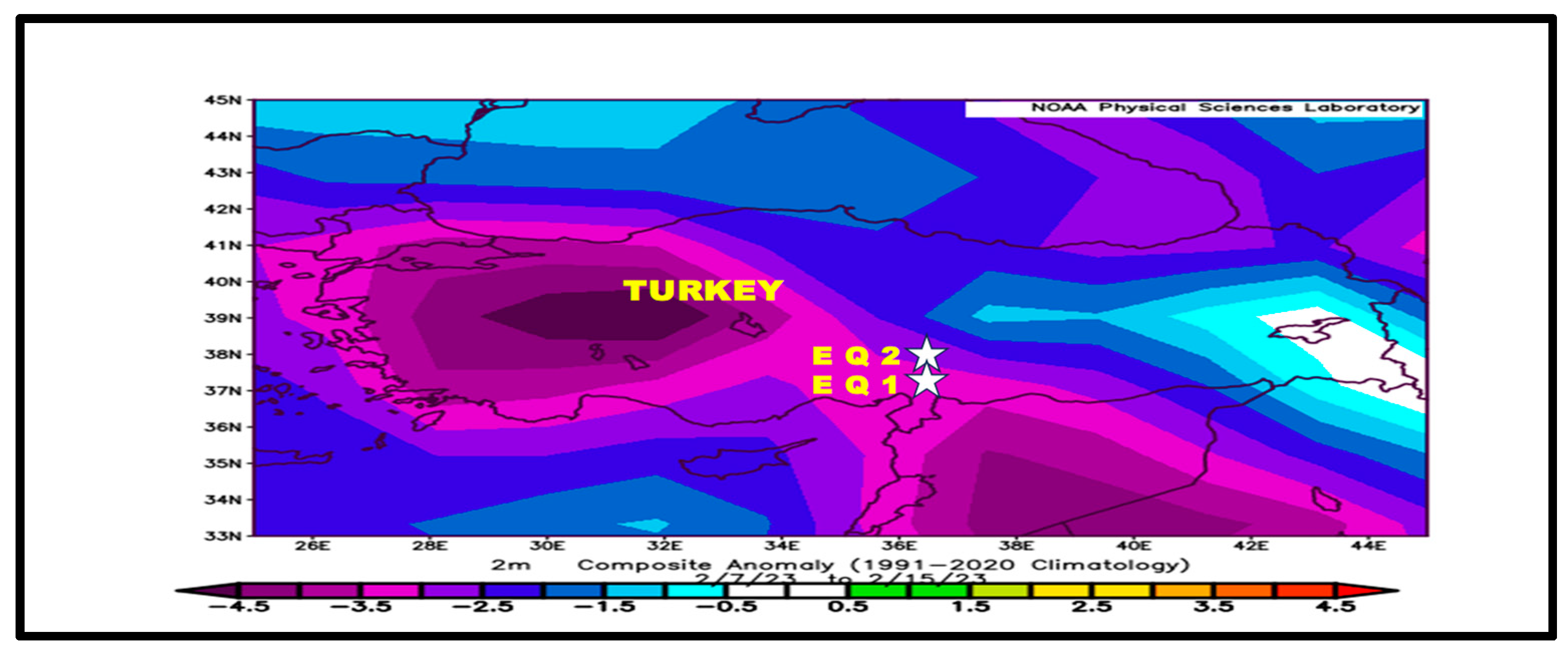
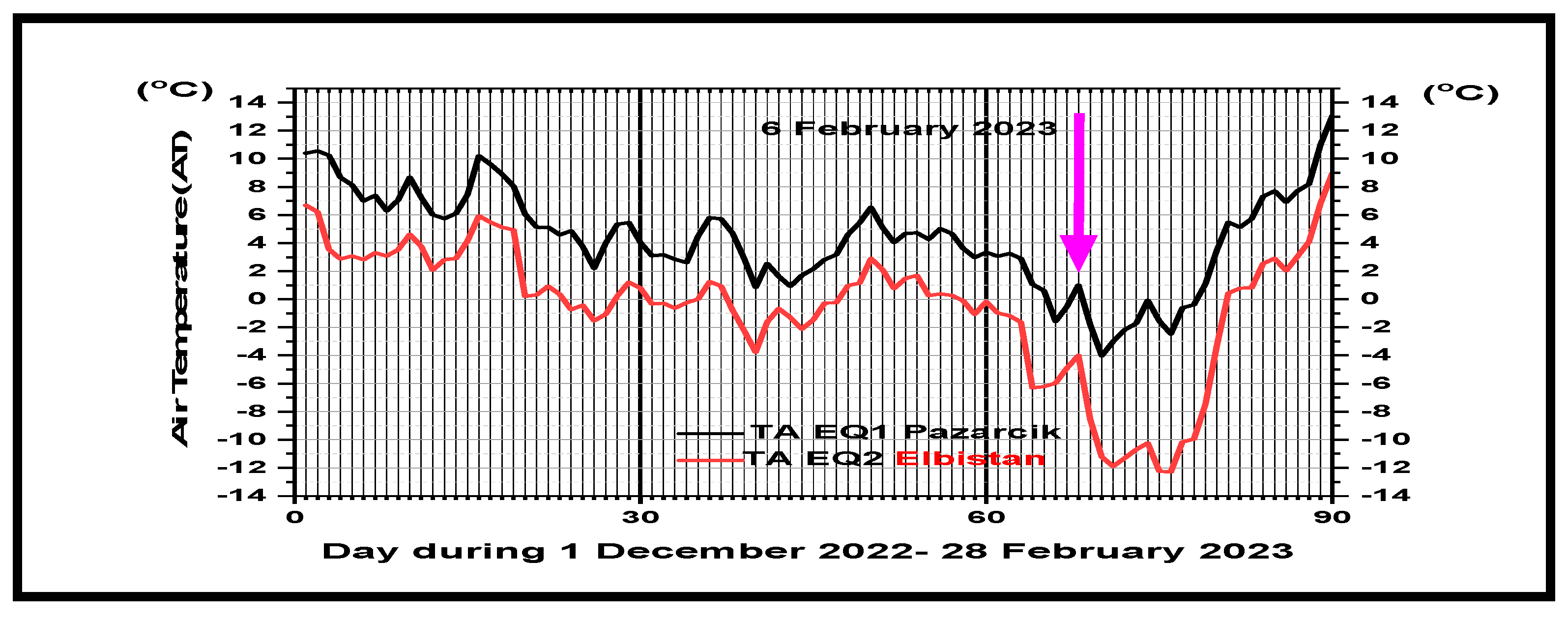
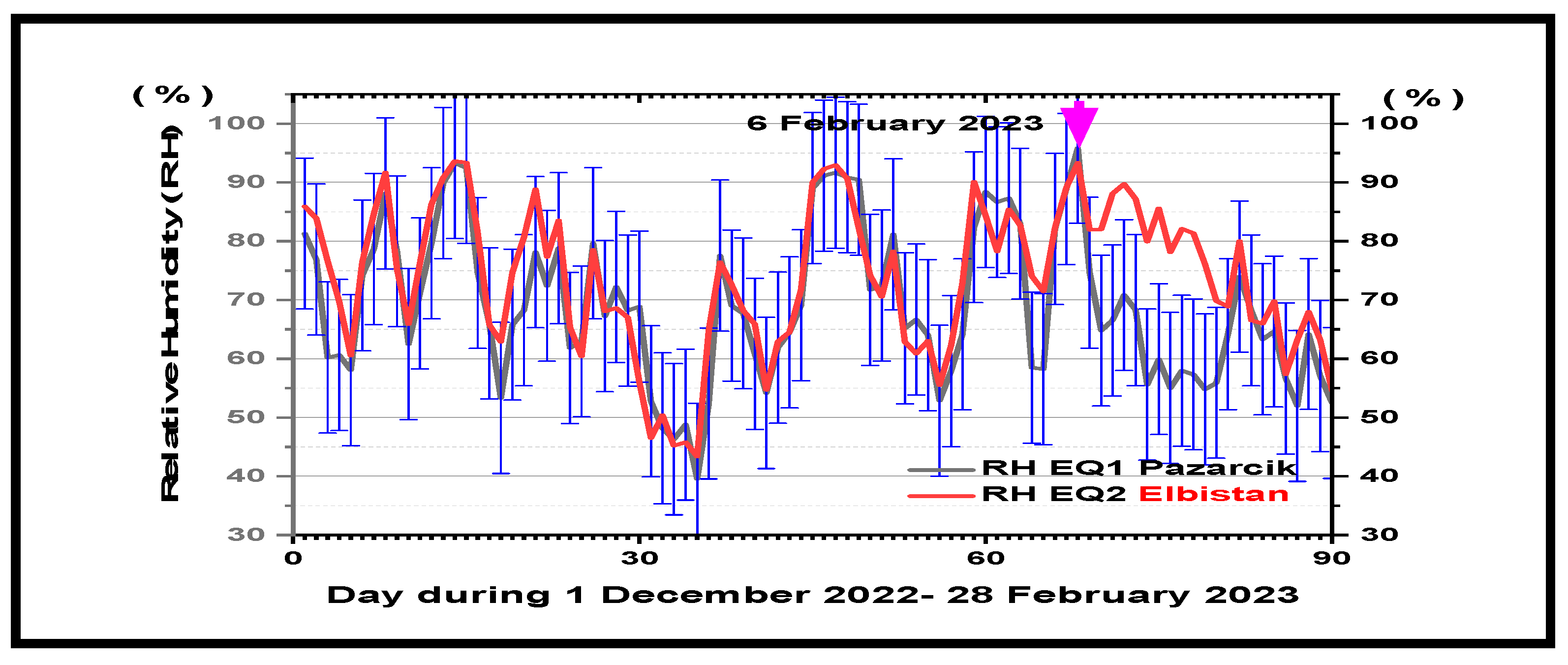
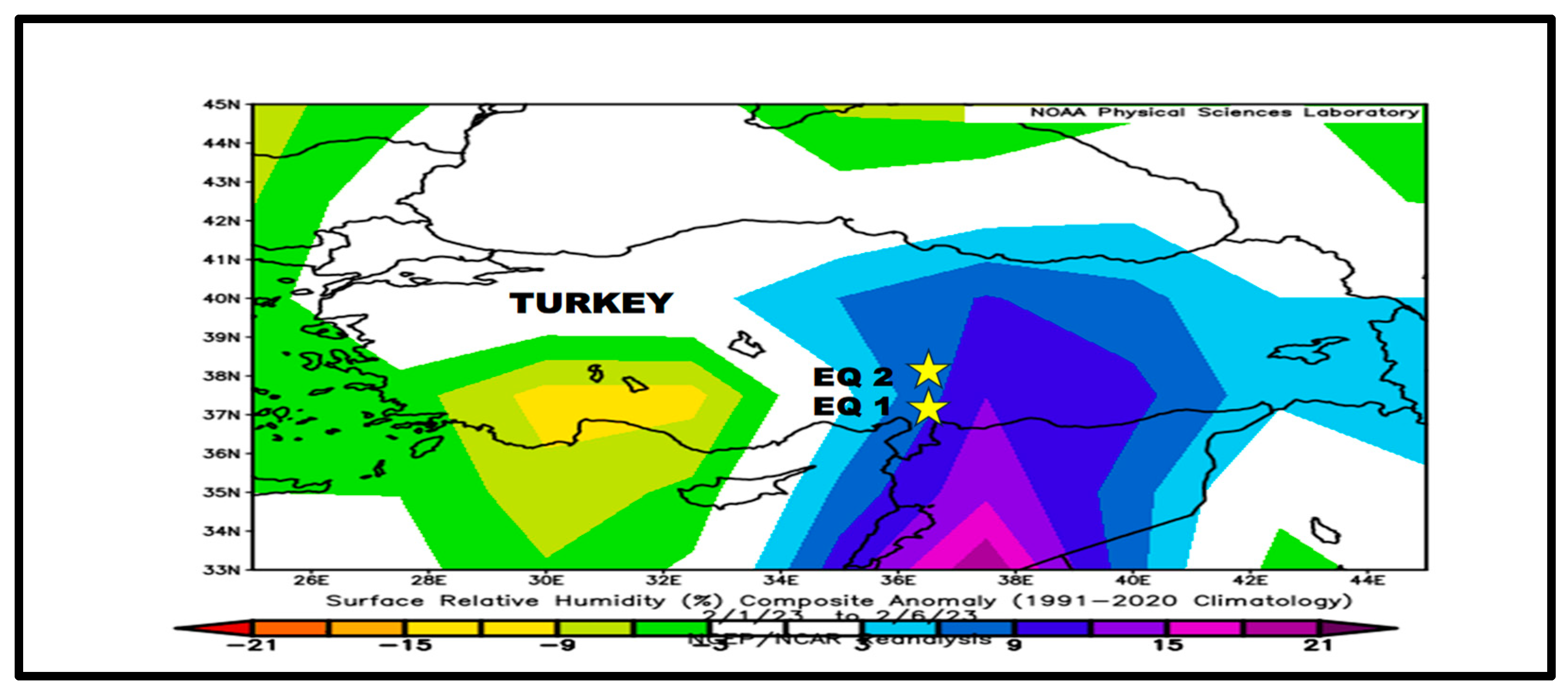
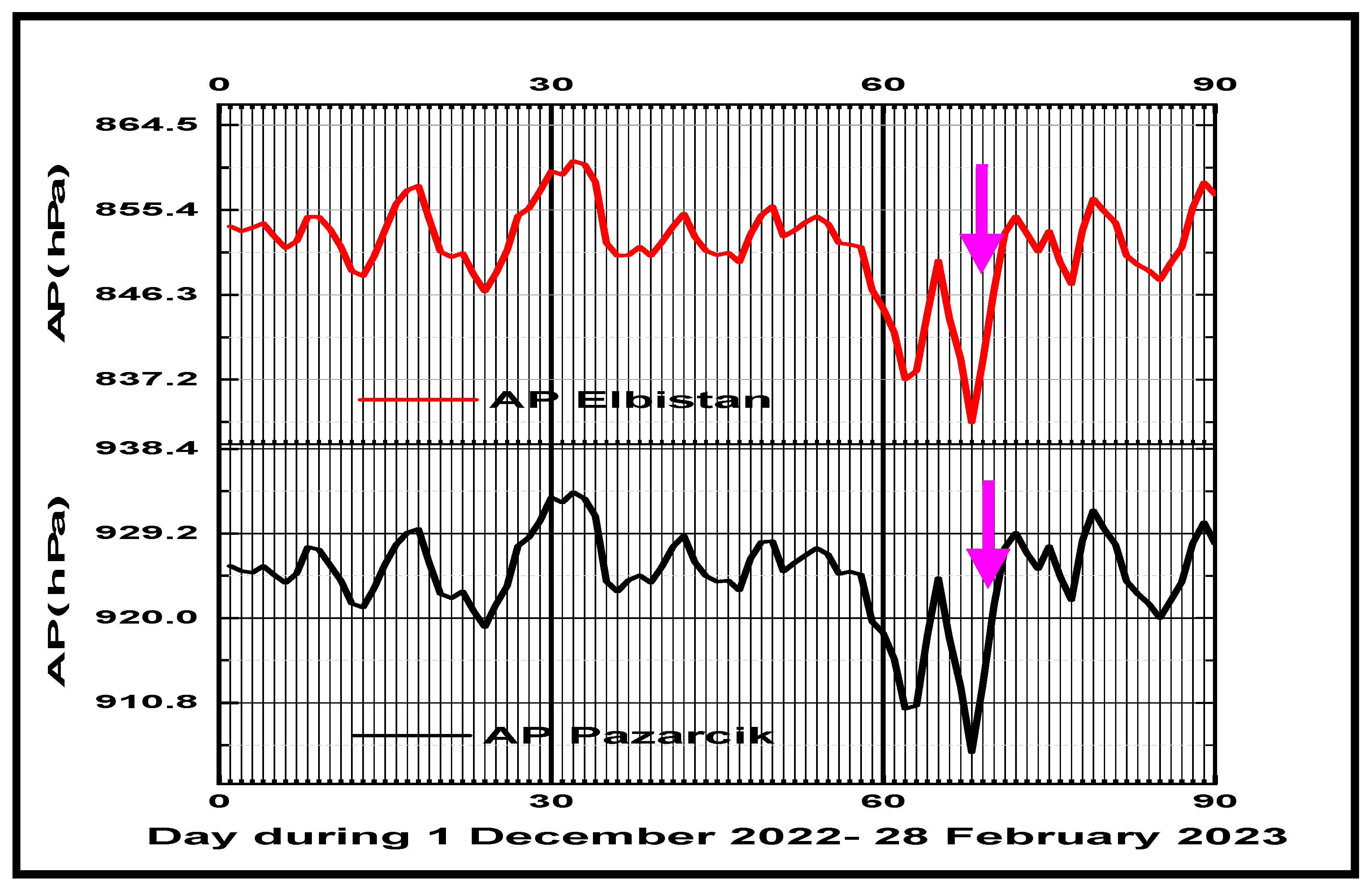
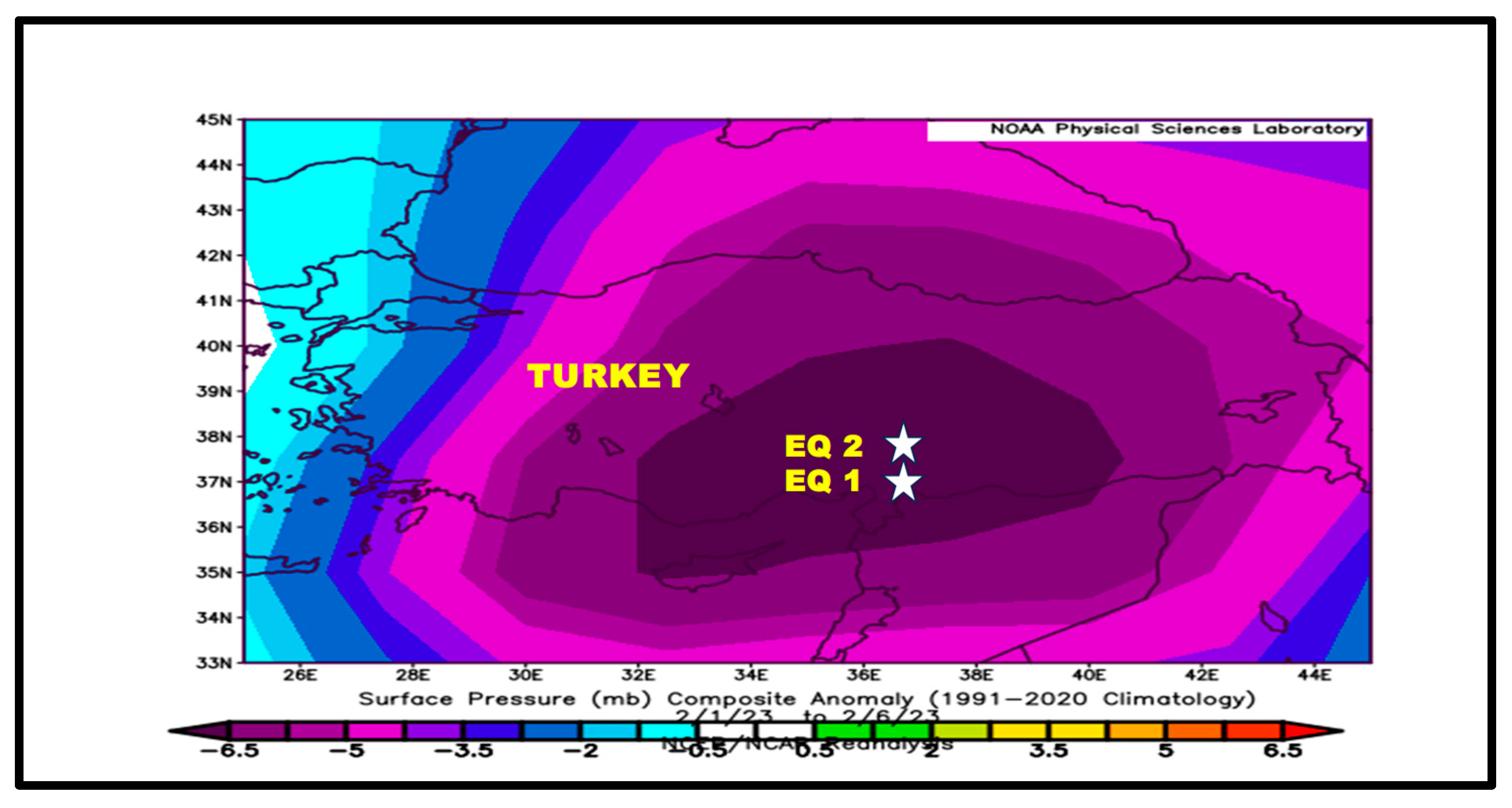
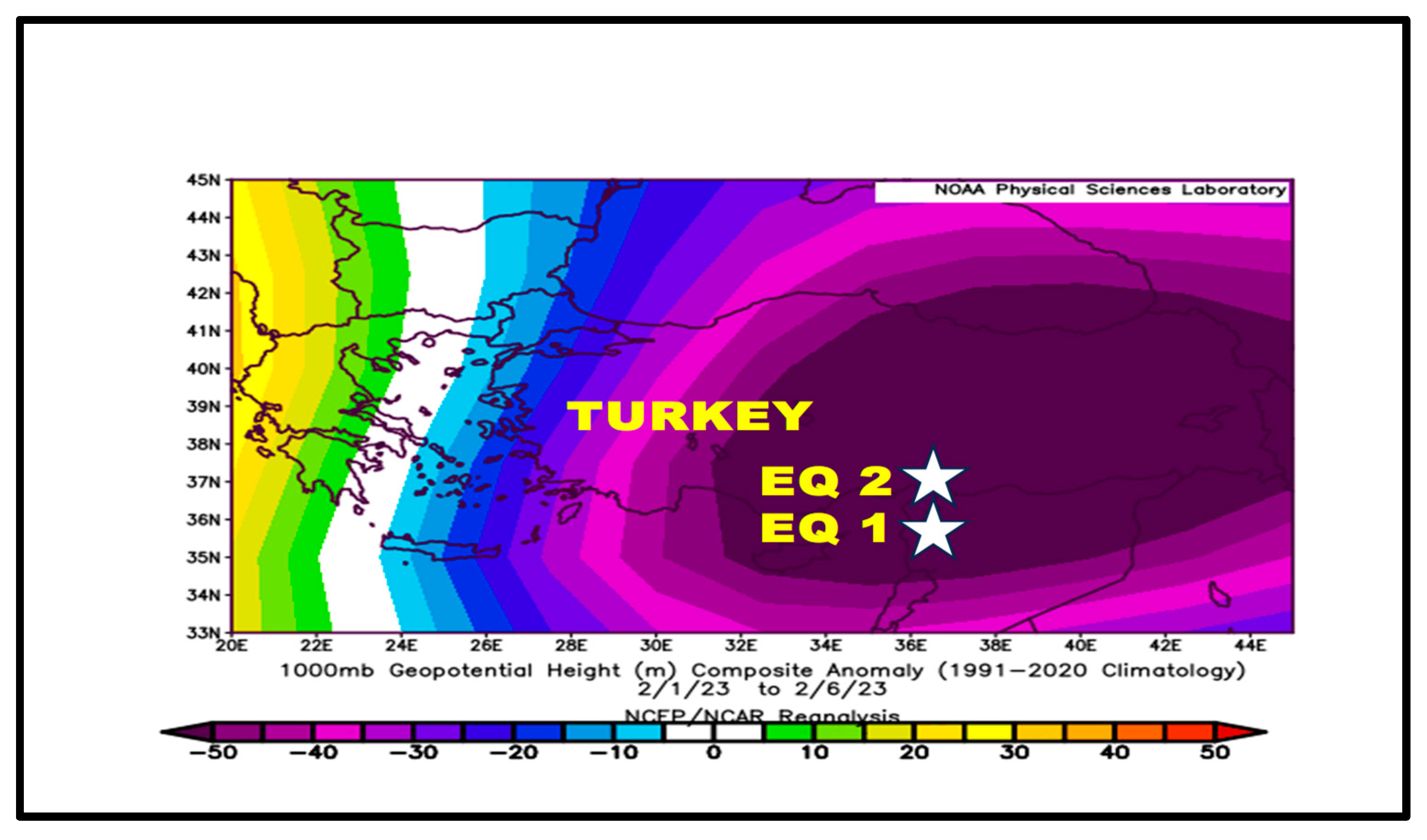
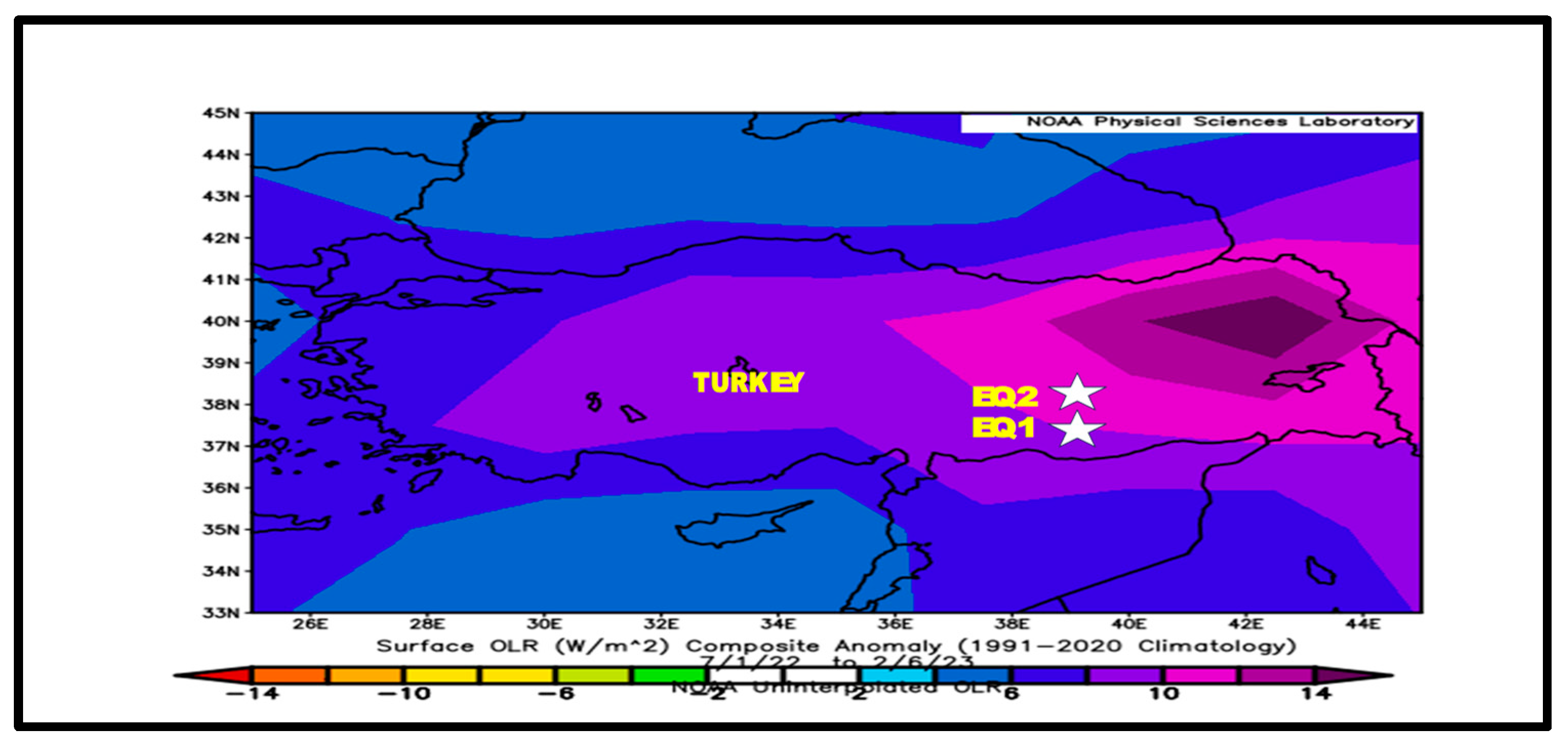
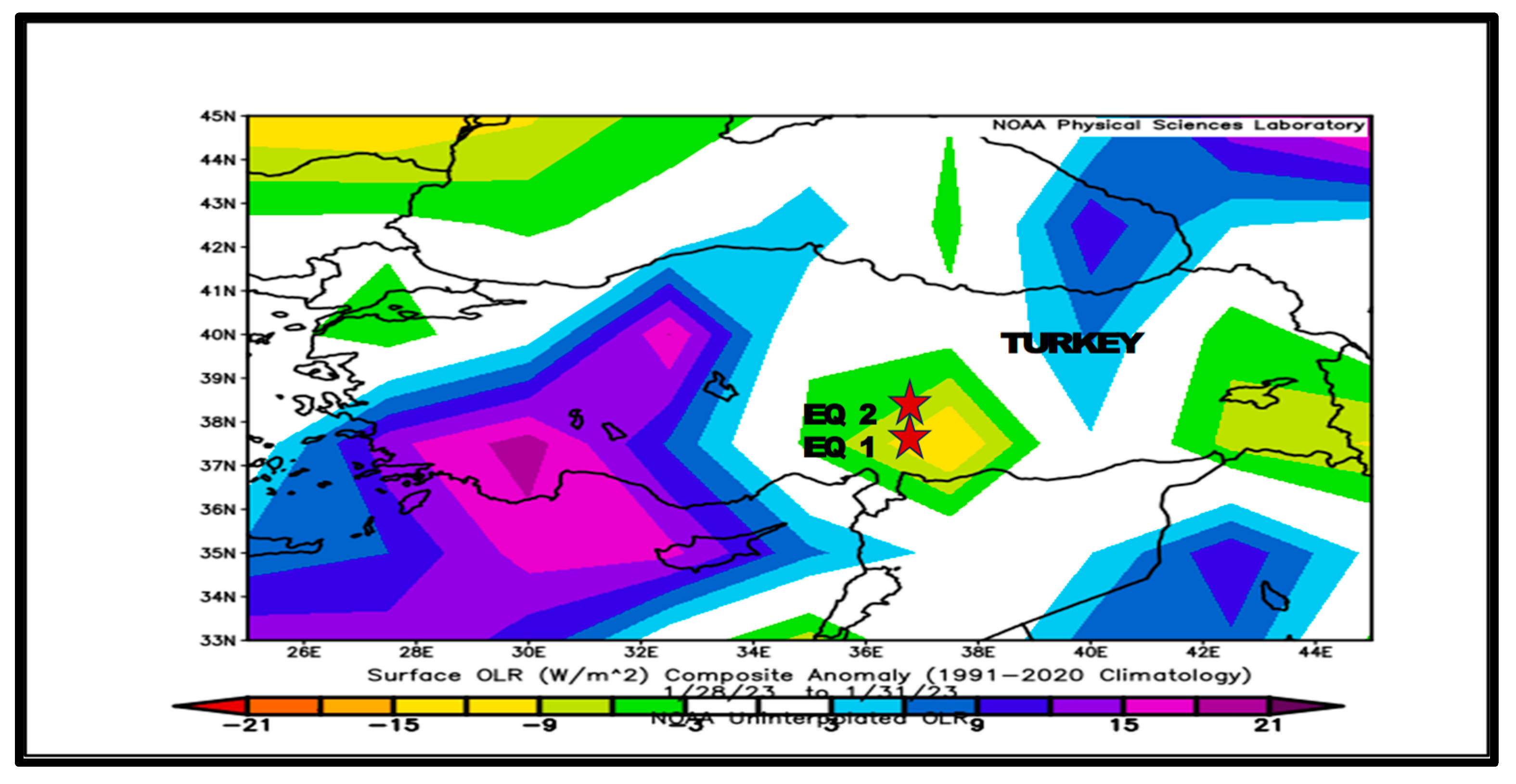
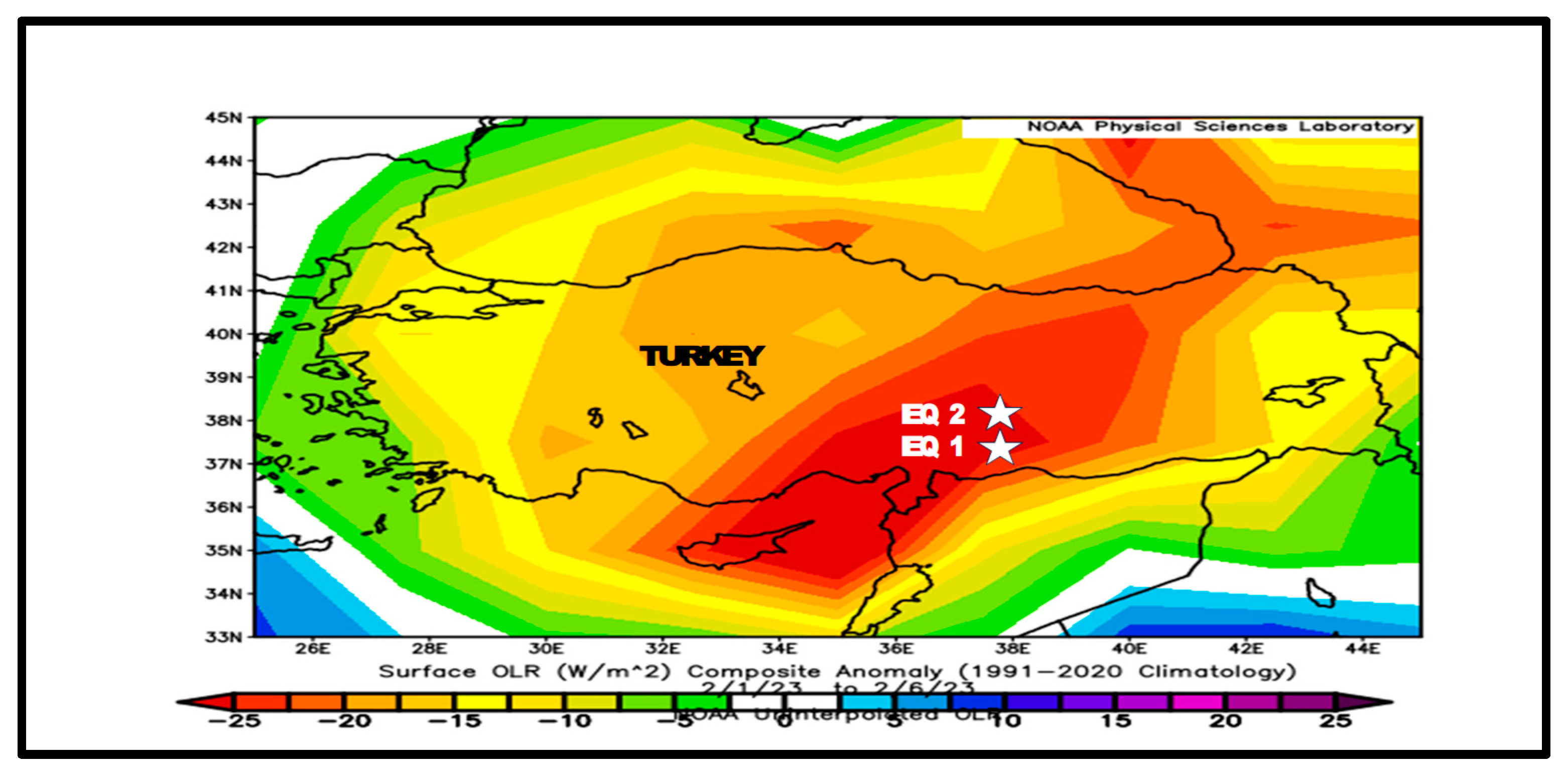
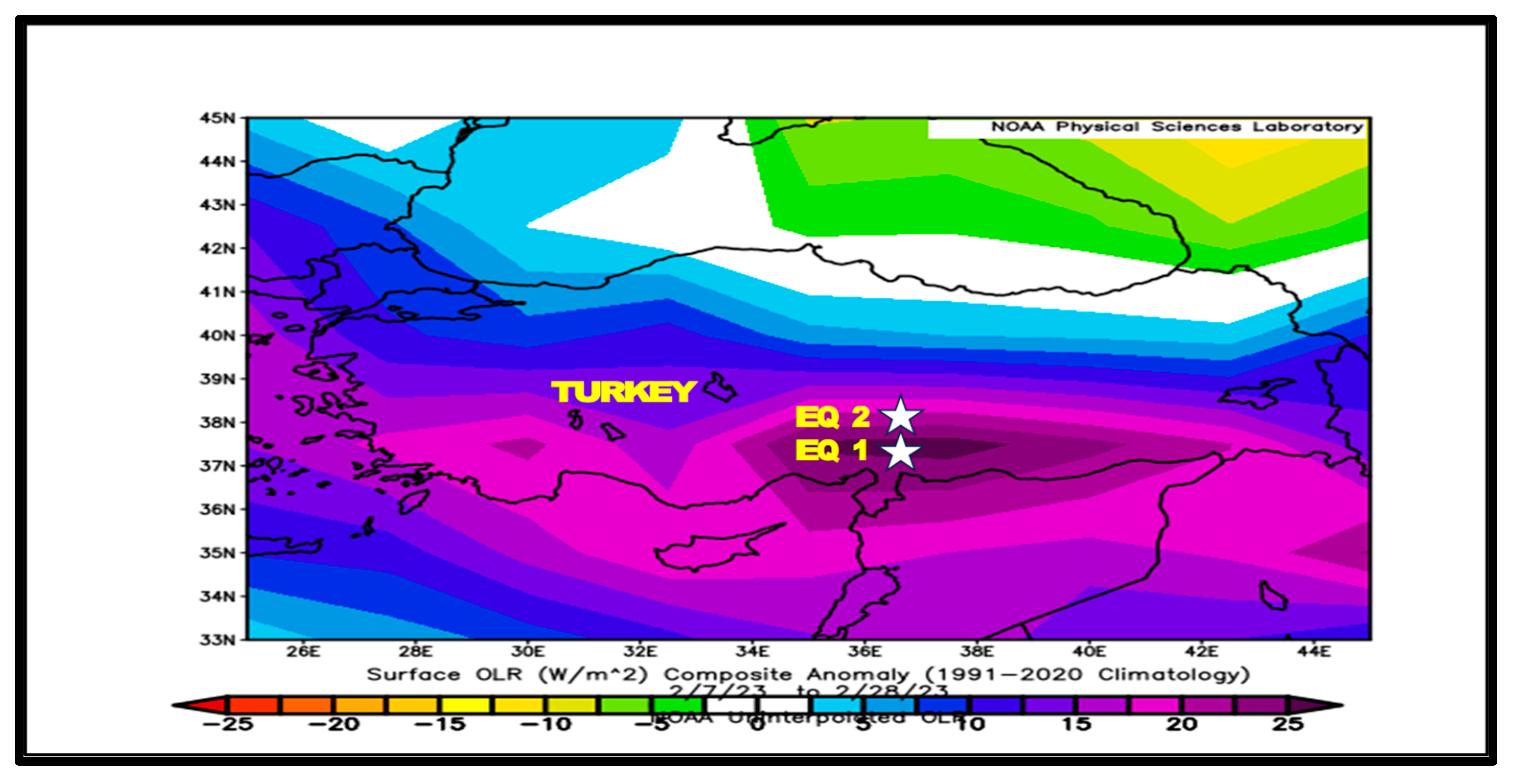
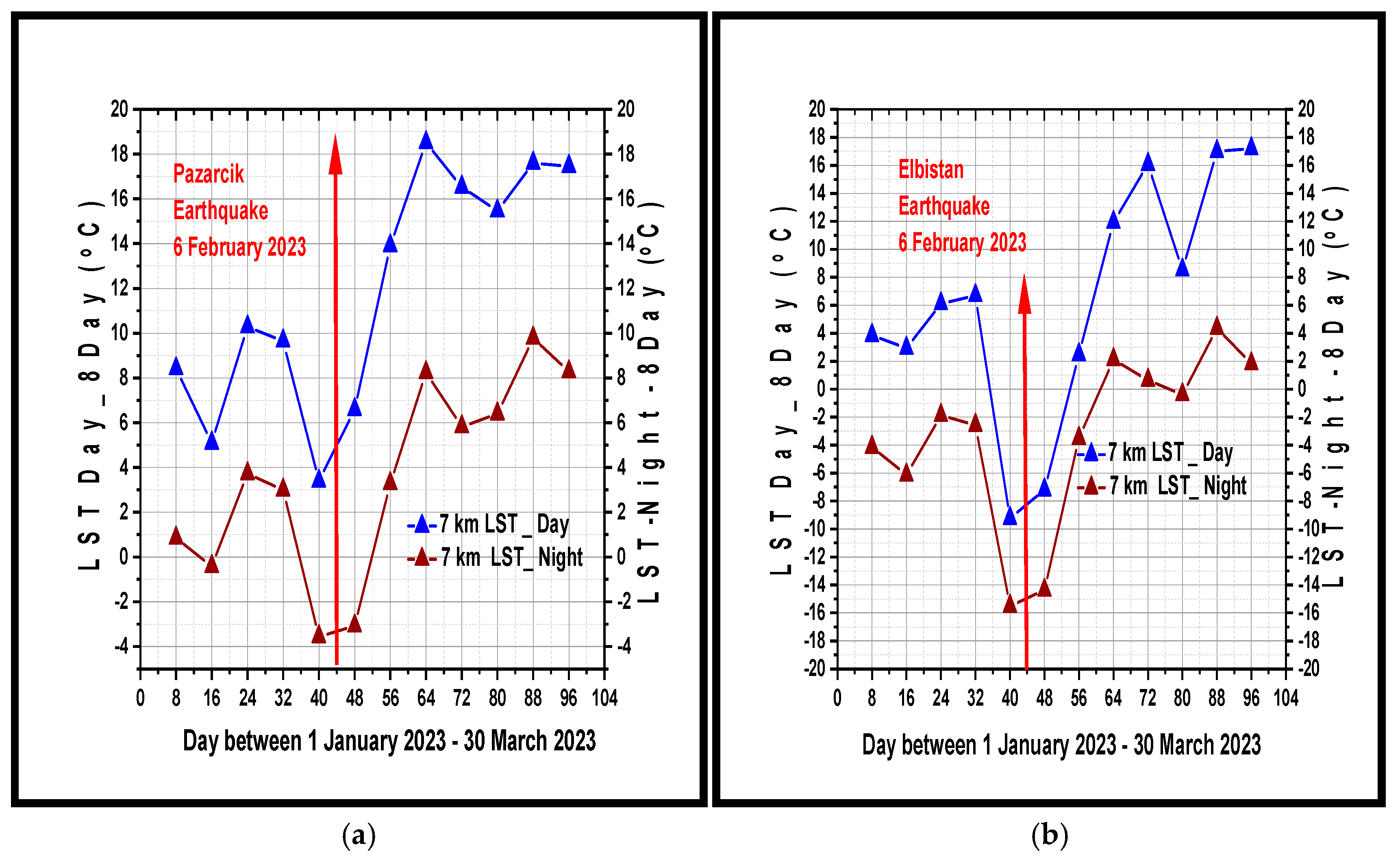
Disclaimer/Publisher’s Note: The statements, opinions and data contained in all publications are solely those of the individual author(s) and contributor(s) and not of MDPI and/or the editor(s). MDPI and/or the editor(s) disclaim responsibility for any injury to people or property resulting from any ideas, methods, instructions or products referred to in the content. |
© 2024 by the authors. Licensee MDPI, Basel, Switzerland. This article is an open access article distributed under the terms and conditions of the Creative Commons Attribution (CC BY) license (https://creativecommons.org/licenses/by/4.0/).
Share and Cite
Zoran, M.; Savastru, D.; Tautan, M. Satellite Signatures of Pre-Seismic Atmospheric Anomalies of 6 February 2023 Türkiye Earthquakes. Atmosphere 2024, 15, 1514. https://doi.org/10.3390/atmos15121514
Zoran M, Savastru D, Tautan M. Satellite Signatures of Pre-Seismic Atmospheric Anomalies of 6 February 2023 Türkiye Earthquakes. Atmosphere. 2024; 15(12):1514. https://doi.org/10.3390/atmos15121514
Chicago/Turabian StyleZoran, Maria, Dan Savastru, and Marina Tautan. 2024. "Satellite Signatures of Pre-Seismic Atmospheric Anomalies of 6 February 2023 Türkiye Earthquakes" Atmosphere 15, no. 12: 1514. https://doi.org/10.3390/atmos15121514
APA StyleZoran, M., Savastru, D., & Tautan, M. (2024). Satellite Signatures of Pre-Seismic Atmospheric Anomalies of 6 February 2023 Türkiye Earthquakes. Atmosphere, 15(12), 1514. https://doi.org/10.3390/atmos15121514





